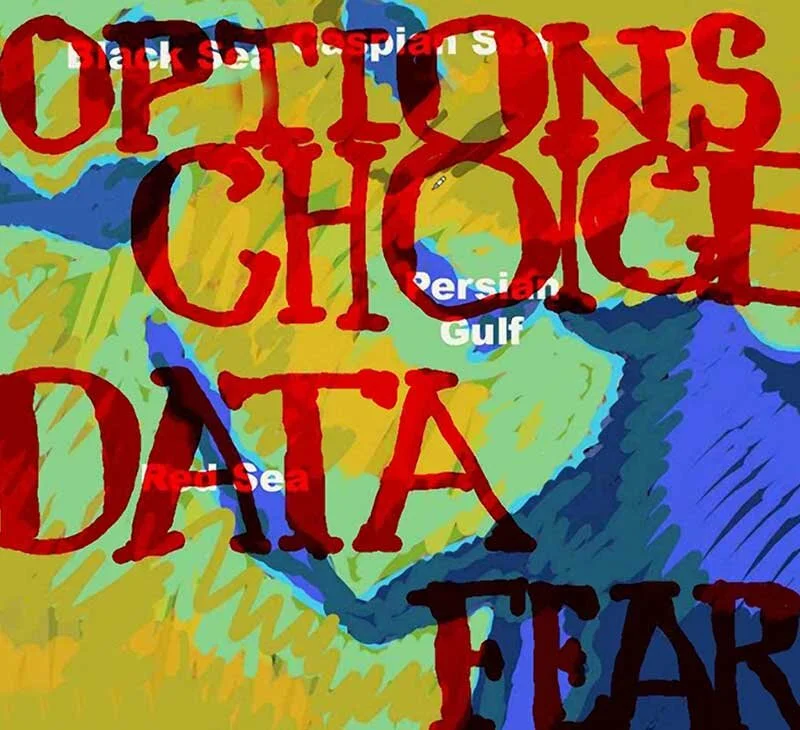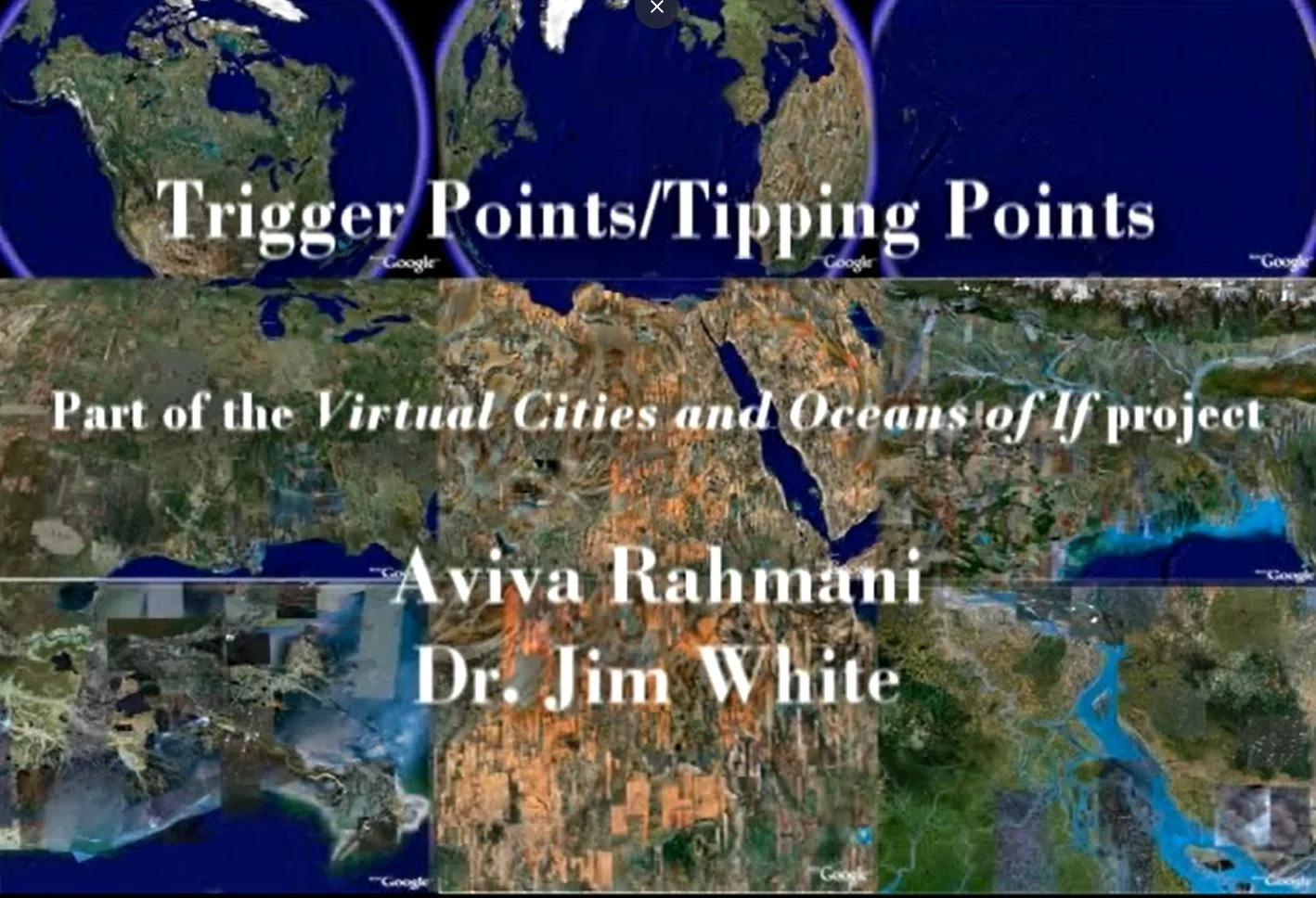Cities and Oceans of If
Cities and Oceans If (2000-2010) imagines a world of “if,” where natural resources were valued and protected. The public art interventions were studies of ecological acupressure “trigger” points across various sites internationally, reinforcing habitat restoration, biodiversity, and interdependence. Experimenting with the virtual and physical and combining artistic inquiry, data collection, and mapping, the project centrally asks, “Can art be used to identify degraded biodiversity hotspots around the world in landscapes and urban regions, whose restoration could affect large-scale landscape healing?
The “If” refers to the world we might live in if natural resources were valued and protected. Broadly conceiving the definition of a site, this project explored how a site’s location could be reconceived as a trigger point for the interdependence between physical, imaginative, and virtual aspects of environmental restoration.
International proposals for public art interventions included sites in Bergen Belsen, Germany; Geumgang, Korea; New Delhi, India, and Pescia, Italy. The goal of restoring sites, to connect fragmented natural resources, has its greatest implications for water. The health of local native fish stocks is one way to track linkage between water systems and habitats.
Virtual Cities and Oceans of If experimented with using the Internet to perform residencies, without the international travel that spews jet fuel over the earth's waters and into her atmosphere. “The physiological cost of traveling to multiple work sites had become as far beyond my personal resources as the fuel use is that taxes our earth. I recognized an opportunity to discover new solutions to our global warming crisis. …The virtual world can leverage sustainable restoration and remediation of degraded ecologies. Virtuality is brilliantly exploited by terrorists. It can equally dramatically serve a different agenda.” —August 2006 “Virtual Cities & Oceans of If” press release.

Pervious, Porous, Integrated Date: 2006 Size: 15’ x 12' x 8' Materials: Cross-media installation: live plants, watering can, painted wall mural and photography Description: Installation at the Exit Art gallery, for The Drop exhibition (2006), a large, labor intensive wall mural about redesigning Manhattan with endemic plants to prepare for flooding caused by sea level rise and climate change. The relationships between Arctic melting, rising water and built infrastructure due to global warming was painted in a short time to reflect how quickly global warming can undo eons of evolution. In the center, a gold circle proposed a redesign of the Manhattan building that was the site of the exhibition.
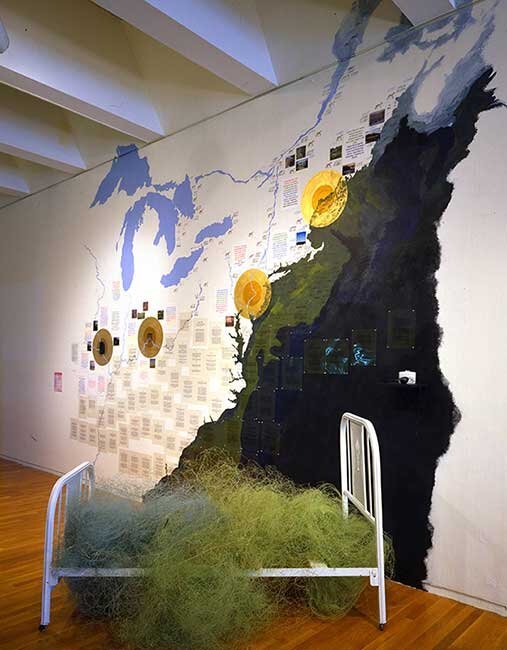
Transformation and Degradation Date: 2002 Size: 45' x 20' Materials: Installation including mural, sound, graphics and iron bed with fish nets. Description: For the Ecovention exhibition (2002) at the Contemporary Arts Center in Cincinnati (CAC). It culminated 12 years research on fisheries and landscape degradation from the Gulf of Maine to the Mississippi River, as part of the Ghost Nets project 1990-2000 and Cities and Oceans of If. Wall mural map in installation envisioned how fresh waterways and fisheries concerns connect the Midwest to the North Atlantic ocean.

'If' Detail Date: 2002 Size: 120" x 456" Materials: Installation mural with GIS graphics. Description: installation detail at the Center for Maine Contemporary Art, Rockport, Maine, GIS graphics created with Dr. Irwin Novak then mounted onto a box construction. The GIS indicated how open urban space might be connected for ecosystem contiguity in coastal fish habitat.

'Listen' Detail Date: 2002 Size: Variable Materials: Photograph Description: detail image from series of graphic installations (Stay Wait Look Listen) designed for Arts in Transit St. Louis, with a landscape restoration proposed for the USML South Station in St. Louis Missouri.
Provenance:
Stills from Cities & Oceans of If have been shown in the following exhibitions: Ecovention, Contemporary Art Center, Cincinnati, OH, 2000; Imaging the River, curated by Amy Lipton, Hudson River Museum, Yonkers, NY, 2003-2004; Visions about Nature, curated by Anke Mellin, Korean Nature Artists Association-Yatoo, Chungnam, South Korea, 2005; Called to Action, curated by Lillian Ball, Art Sites, Riverhead, NY; The Drop curated by Jodi Hanel, Exit Art, New York City, NY, April 8 - June 10, 2006 and Groundworks, curated by Grant Kestor, Regina Miller Gallery, Carnegie Mellon University, Pittsburg, PA, 2005.
Publications:
Spaid, Sue. Ecovention: current art to transform ecologies. Cincinnati, Ohio: Contemporary Art Center, greenmuseum.org and ecoartspace, 2000.
Auses, Jack; Kester, Grant and Strayer, Jenny Eds. Groundworks Pennsylvania: Carnegie Mellon University, 2005.
Mellin, Anke, Visions About Nature. South Korea: The Korean Nature Artists Association-Yatoo, 2005.
Genocchio, Benjamin. “Digging In to Nurture Nature.” New York Times May 20, 2007.
Rahmani, Aviva. “Mapping Trigger Point Theory as Aesthetic Activism.” PJIM, Vol.4, Issue 2, Winter pp.1-9, 2012.
Rahmani, Aviva. “A Community of Resistance: Collaborative Work with Science and Scientists.” WEAD Magazine. Online publication Issue 7, CREATING COMMUNITY, available at: http://weadartists.org/communities-art-science, 2014.
SANZ is scientists and artists united for net zero.
We are climate change scientists, ecoartist-researchers and practitioners (ecoartists engage with environmental systems change) who share your vision for an existential and pragmatic race to net-zero.
Please read our Letter to John Kerry and add your name to the letter on our Sign Here page.
Our logo uses Helsingin Sanomat's new Climate Crisis font.
Climate change is a lengthy and abstract phenomenon, and as such difficult to grasp for us humans. We have been wired to react more to the threats we can easily observe. This is why the Nordic’s largest newspaper Helsingin Sanomat created The Climate Crisis Font – an OpenType variable font that helps people see the urgency of climate change in a more tangible form. The font’s weight responds to NSIDC’s (National Snow and Ice Data Center) Arctic sea ice data from 1979 to 2019 and IPCC’s prediction all the way to 2050, showing how the ice is expected to shrink because of climate change based on current forecasts.
Free font download for visualising the urgency of the climate crisis: https://kampanjat.hs.fi/climatefont
If you have any questions, please contact either:
Aaron Ellison PhD
Senior Research Fellow in Ecology, Harvard Forest, Harvard University at aellison@fas.harvard.edu
Aviva Rahmani, PhD
“We are at this most critical moment … to get to net zero carbon in 2050.”
~ John Kerry, January 21, 2021
News
August 12th - since April SANZ has affiliated with Arts Cabinet UK and other representatives of agencies in Canada and the United States to develop strategies for COP26.
April 6th - SANZ met with Nancy Szalwinski, Director and Ed Findlay Deputy Director of Cultural Programs Division, Bureau of Educational and Cultural Affairs | U.S. Department of State
A Letter to Special Presidential Envoy for Climate John Kerry
Please read the letter below and if you agree, then please add your name by using our Sign Here form.
Thank You!
Aaron Ellison PhD, Senior Research Fellow in Ecology, Harvard Forest, Harvard University at aellison@fas.harvard.edu
Aviva Rahmani, PhD, Affiliate at the Institute for Arctic and Alpine Research, University of Colorado at Boulder, CO. www.avivarahmani.com at ghostnets@ghostnets.com
March 25, 2021
Dear Special Presidential Envoy for Climate John Kerry,
SANZ is scientists and artists united for net zero [1]. We are climate change scientists, ecoartist-researchers and practitioners (ecoartists engage with environmental systems change) who share your vision for an existential and pragmatic race to net-zero [2][3]. We write to join with you in the effort to amplify outreach and effect systemic changes towards that goal [4]. We would welcome the opportunity to meet with you and discuss how we can be of service in realizing mutual goals. We offer decades of interdisciplinary experience in application, adaptation, adoption, development and scaling-up creative partnerships between policy makers, scientists and ecoartists including with existing groups, such as ecoartspace and the ecoart network [5][6][7].
We propose a rapid (six-month) planning process, coordinating with the NEA, NSF, DOE, NASA, NOAA, the Climate Change Corps, Indigenous Groups such as Honor the Earth in the United States and reaching out internationally, to create teams who can work on solutions to climate change.
Our goal is to identify opportunities and deliver concrete proposals to implement ecoart/science partnerships. These partnerships could foster, support and establish: fair and equitable processes to identify and select participants; balance financial and logistical/production/research support for scientists and artists; create an outreach, communication and marketing plan; and establish realistic modes of evaluation and assessment.
We believe our nation must embrace and use all our talents to meet this challenge. Scientists have been trying—mostly unsuccessfully—for decades to effect change [8]. We need to embed new collaborative approaches in climate change policy [9].
Our observation is that that ecoart can amplify the audibility and visibility of climate science and contribute new insights. Conversely, without science, ecoarts’ contributions can be disregarded. Initiatives in other countries have recognized this opportunity through, for example, the Intergovernmental Panel on Art and Climate Change (IPACC) proposed by the Jan van Eyck Academy in the Netherlands [10][11].
Historically, modest investments in art/science collaborations and inter-agency projects of all kinds within the United States have yielded spectacular scientific insights and mainstream impacts from data visualization and modeling to practical solutions, particularly in cities [12][13][14]. Often these collaborations have bolstered industrial innovation [15]. The larger artworld represents a significant economy (over $68 billion) [16]. Inspiring the imagination of that sector might further contribute towards our net zero goal [17].
This is an opportunity for the United States to assume greater leadership in these matters and engage with wider global cultural partnerships. We hope to hear from you at your earliest convenience.
Thank you for your time and attention.
Further information on request. Please respond to either Dr. Aaron Ellison or Dr. Aviva Rahmani on our Contact page as your primary contacts. See below for additional signatories, statistics and citations.
References:
[1] The Intergovernmental Panel on Climate Change: www.ipcc.ch/sr15/chapter/spm/
[2] UN News: news.un.org/en/story/2020/12/1078612
[3] The Washington Post: www.washingtonpost.com/politics/2021/02/22/kerrys-claim-that-we-have-nine-years-left-avert-climate-crisis
[4] Proceedings of the National Academy of Sciences of the United States of America: www.pnas.org/content/pnas/early/2010/06/04/1003187107.full.pdf
[5] American for the Arts: www.americansforthearts.org/by-topic/social-change
[6] ecoartspace: www.ecoartspace.org
[7] Ecoart Network: www.ecoartnetwork.org
[8] Center for Climate and Energy Solutions: www.c2es.org
[9] PolicyLink: www.policylink.org/resources-tools/working-with-artists
[10] The Intergovernmental Panel on Climate Change: www.ipcc.ch
[11] Jan Van Eyck: www.janvaneyck.nl/postacademy/about
[12] The Conversation: theconversation.com/engineers-have-built-machines-to-scrub-co-from-the-air-but-will-it-halt-climate-change-152975
[13] National Assembly of State Arts Agencies: nasaa-arts.org/nasaa_research/return-on-investment
[15] MIT Technology Review: www.technologyreview.com/2014/04/15/173149/the-underappreciated-ties-between-art-and-innovation/
[16] Art | Basel: www.artbasel.com/news/art-market-report
[17] NASA Global Climate Change: climate.nasa.gov/scientific-consensus
Selected Appendix for online resources:
Evidence of climate change catastrophe:
https://www.pnas.org/content/pnas/early/2010/06/04/1003187107.full.pdf
Evidence of the Social Impact of art:
Arts Fund: https://www.artsfund.org/social-impact-study-2018
National Endowment for the Arts: https://www.arts.gov/sites/default/files/Research-Art-Works-Chicago.pdf
Taylor & Francis Online: https://www.tandfonline.com/doi/pdf/10.1080/14797580903481280
World Economic Forum: https://www.weforum.org/agenda/2020/10/how-arts-and-culture-can-serve-as-a-force-for-social-change
Evidence of public opinion shifts:
Center for Climate Change Communication: https://www.climatechangecommunication.org
Selected additional relevant organizations:
Ars Electronica: https://ars.electronica.art/center/en
British Council: https://www.britishcouncil.org/arts/culture-development/our-stories/creative-commissions
Climate Cultures: https://climatecultures.net/about/about-climatecultures
COAL Prize: http://www.projetcoal.org/coal/coal-art-developpement-durable/contact
The Earth Institute, Columbia University: https://www.earth.columbia.edu
Ecoart Network: https://www.ecoartnetwork.org
Ecoarts: http://www.ecoartsonline.org
Ecoartspace: https://ecoartspace.org
eco/art/scot/land: http://ecoartscotland.net
Honor the Earth: https://www.honorearth.org
Julie’s Bicycle: https://juliesbicycle.com
Leonardo: https://www.leonardo.info
PolicyLink: https://www.policylink.org/resources-tools/working-with-artists
Taylor & Francis Online: https://www.tandfonline.com/doi/full/10.1080/02604027.2018.1444837
The Washington Post: https://www.washingtonpost.com/politics/2021/02/22/kerrys-claim-that-we-have-nine-years-left-avert-climate-crisis
Yale Program on Climate Change Communication: https://climatecommunication.yale.edu/about/people-partners/the-yale-climate-and-energy-institute
2020 Visions: https://www.2020visions.art
Relevant statistics about museum public reach:
Signatures
This list will be updated every few days with the latest additional signatures.
Mary Jo Aagerstoun, https://www.facebook.com/groups/751890081595539
Valerie J. Amor, Drawing Conclusions, LLC, https://www.facebook.com/DrawingConclusionsLLC/
Marcia Annenberg, Teachers College, Columbia University, http://www.mannenberg.com
Krisanne Baker, http://www.krisannebaker.com
Lillian Ball, www.waterwash.org
Sibel Bargu Ates, Department of Oceanography and Coastal SciencesLouisiana State University, 1002T
Suzanne Benton, Independent artist, http://suzannebentonartist.com
David Bergman, New York School of Interior Design & Parsons School of Design, http://davidbergmaneco.com
Resa Blatman, Visual Artist, http://www.resablatman.com
Claudia Borgna, www.claudiaborgna.org & www.claudiaborgna.com
Bill Botzow
Sam Bower, Independent consultant, Regenerative Culture researcher, greenmuseum, https://animatingdemocracy.org/resource/environmental-art
Wendy Brawer
Bebonkwe Brown, Plains Cree / Anishnawbe / Metis Nations, http://www.Winter-Brown.com
Jenny Brown, www.jennybrownjenny.com
Rebecca Burrill, https://horsechestnutwinds.com
Beth Carruthers, Canada: https://ecuad.academia.edu/BethCarruthers SongBird project (archive) https://www.songbirdproject.ca/
Prosanta Chakrabarty, Fulbright Canada, Carleton University, Ottawa, LSU Museum of Natural Science, 119 Foster Hall, Baton Rouge, LA 70803-3216,
Richard Chinn, Environmental Training, Inc., 804 Cottage Hill Way, Brandon, FL 33511-8098
Laurie Beth Clark, https://lbclark.net
Betsy Damon, www.KeepersoftheWaters.org
Cyane Dandridge, Strategic Energy Innovations, http://www.seiinc.org
Cameron Davis, University of Vermont, Department of Art & Art History, Environmental Program Affiliate, EcoCulturelab, http://www.camerondavisstudio.com
Gillian T. Davis
Dominique de Cock, http://www.dominiquedecock.com
Elizabeth Demaray, https://elizabethdemaray.org
Susan Dennehy, Art Students League, http://dennehylawfirm.com
Thomas Erben, Director, Thomas Erben Gallery, https://www.thomaserben.com
Chris Fremantle, Gray's School of Art,Robert Gordon University, http://ecoartscotland.com
Amara Geffen, https://www.amarageffenstudios.com/
Chris Greenwood, Red Line Art Works, http://www.redlineartworks.org
David Haley
Newton Harrison, http://www.centerforforcemajeure.org
Noel Hefele, Independent artist, http://noelhefele.com
Debbie Henderson, Wittenberg Univ.
Paula Higa, The University of Vermont, http://www.paulahiga.com
Angelika Hilbeck
Susan Hoenig, www.susanhoenig.com
Jon Barlow Hudson, http://www.hudsonsculpture.art
Basia Irland, http://www.basiairland.com
Michelle Jaffé, Independent Artist, http://michellejaffe.com
Patricia Johanson, https://patriciajohanson.com
Lucy Keshavarz, President, Art & Culture Group, Inc., http://ArtCultureGroup.com
Sant Khalsa, http://www.santkhalsa.com
Susan Knght, independent artist, http://www.susanknightart.com
Ellen Kozak, Pratt Institute, visual artist, http://ellen@ellenkozak.com
Kim Landsbergen, Antioch College, http://KimLandsbergen.com
Ellen K. Levy, www.complexityart.com
Stacy Levy, www.stacylevy.com
Sally Linder, http://www.sallylinder.com
Taina Litwak, Independent artist, http://www.litwakillustration.com
Kam-Biu , Liu, Louisiana State University, Baton Rouge, La. 70803
Patrick Lydon, City as Nature, Art and Media Lab, http://cityasnature.org
Ana MacArthur, independent artist, http://www.anamacarthur.com
Cindy Maguire, Adelphi University, http://Artsaction.org
Kanchan Maiti, Louisiana State University, Baton Rouge, La. 70803
Lenore Malen, Parsons—The New School, http://lenore.malen@gmail.com
Helen Mann, University of the Arts, London (UAL), http://www.instagram.com/hm.encounters/
Mary Mattingly, University of Hartford, http://www.marymattingly.com
Bridget McKenzie, Climate Museum UK, http://climatemuseumuk.org/
Virginia McLean, Friends for Our Riverfront, http://www.friendsforourriverfront.org/index.html
Jill McManus, Free lance musician/writer
Daro Montag, daro.montag@falmouth.ac.uk
Adrienne Moumin, Independent Artist, http://Picturexhibit.com
Beverly Naidus, www.beverlynaidus.net
Devora Neumark, PhD, Goddard College, http://devoraneumark.com
Chrissie Orr, https://seedbroadcast.org
Carol Padberg
Greg Patch, artist, http://gregpatch.blogspot.com
Kate Pellegrini, Culture Declares Emergency, http://katepellegrini.com
Deanna Pindell, Olympic College, WA, USA, http://deannapindell.net
Nancy N. Rabalais, Louisiana State University, Baton Rouge, La. 70803
Aviva Rahmani, INSTAAR, University of Colorado at Boulder, www.avivarahmani.com
Gustavo A. Rincon, University of California, Santa Barbara
Luzita Roll, Independent Art Educator
Catherine Ruane, Victor Valley College, http://www.catherineruane.com
Valeria Ruiz Vargas, Manchester Metropolitan University, https://www.mmu.ac.uk/natural-sciences/staff/profile/index.php?id=2651
Christina Rupp, www.Christyrupp.com
Hope Sandrow, Open Air Gallery
Henry Sayre, Oregon State University
Claude Schryer, Canada Council for the Arts, https://nac-cna.ca/en/bio/claude-schryer
Joyce Pomeroy Schwartz, Public Art curator and advisor
Fern Shaffer, http://Fernshaffer.com
Bonnie Ora Sherk, Systemic Ecological Design, Landscape Architecture, Integrated Community & Schools' Education, http://www.alivinglibrary.org
Suzan Shutan, Independent artist, Housatonic Community College, http://www.suzanshutan.com
Danielle Siembieda, Leonardo/ISAST
Nina Sobell, Independent Artist, http://www.ninasobell.com
Debra Solomon, PhD candidate Dept of Urban Planning, University of Amsterdam, http://www.urbaniahoeve.nl
R. Eugene Turner, Louisiana State University, Baton Rouge, La. 70803
Hanae Utamura, Independent Artist, http://www.hanaeutamura.com/
Jan von Boeckel
Jennifer WAGNER-LAWLOR, Penn State University
Ruth Wallen, www.ruthwallen.net
Patricia Watts, ecoartspace LLC
Linda Weintraub
James White, Univ of CO at Boulder, CO
Roscoe Wilson, Miami University, http://www.roscoewilson.com
Marina Zurkow, www.o-matic.com , www.dearclimate.net
Cheryl Safren, independent artist, public artist, http://safren.com
Jenny Kendler, Artist, NRDC Artist-in-Residence, Board Member at 350.org, http://jennykendler.com
Richard Solomon, PhD, Community clinical psychologist (Retired)
Amanda Schockling, Master's Student, Lund University
Rosie Farr, UN Principles for Responsible Investment
Alice Garik, independent artist, http://www.alicegarik.com
Claudia Hart, School of the Art, Institute of Chicago, http://www.claudiahart.com
Usha Rao, Environmental Geochemistry Researcher and Professor, Saint Joseph's University
Tessa Teixeira, Independent Artist, http://www.tessateixeira.com
Julie Reiss, Independent Scholar, http://juiereiss.com
Masooma Razvi, Pharmacist, Independent
Monika Fabijanska, Independent Curator and Art Historian, http://www.monikafabijanska.com
Nicholas Minor, University of Wyoming, http://nicholasrminor.com
Jayme McLellan, Adjunct Lecturer, Georgetown University; artist; graduate student, Harvard Ext. School; and gallery director, http://Www.Civilianartprojects.com
Fish Story
Fish Story (2013) emerged out of a series of discursive webcasts initiated by Rahmani in 2010, to Gulf to Gulf [HL1] . Fish Story was a participatory public art project about how the lives of fish in the Mississippi River reflect human challenges in the Anthropocene era. Fish Story events included bringing people together to embody and take the roles of different agents of change for a game about an ecosystem, including the roles of habitat, politicians, pollution, and racism, to invite new perceptions on causal effects. The project resulted in a deepened study of finding the “trigger point” where pollution flowing into the water system from Memphis to the eutrophying Gulf of Mexico might be mitigated.
The project applies Aviva Rahmani’s Trigger Point Theory to the bioregion of the Mississippi Water Basin from base in Memphis. The Gulf to Gulf team (Aviva Rahmani; Dr. Eugene Turner, LSU; and Dr. Jim White, UCB) was invited to create this project for Memphis Social by curator Tom McGlynn, cofounder of Beautiful Fields, which was awarded the domestic 2013 franchise support grant from apexart to produce Memphis Social.
The Gulf to Gulf team collaborated to show synergy between environmental factors, including climate change, affecting indicator species of fish in the Mississippi, in the vicinity of Memphis. Many people are not aware that fish are affected by all the same factors causing disruptive drought, storms, temperature extremes, and flooding worldwide that impact people. The team chose Memphis as a critical point between factory farms upstream and dead zones downstream in the Gulf of Mexico, affecting the survival of fish. Dr. Turner noted the “trigger point” for healing dead zones in the Gulf of Mexico is Iowa, because it's at the center of Midwestern factory farms releasing nitrogen into the water system flowing into the gulf. The goal of Fish Story was a series of events to support local and regional conservation and enhance restoration science. Fish Story's progress was tracked on Rahmani's blog, Pushing Rocks, in 100 posts. An outcome of this project was the rough mathematical calculation by Dr. White, based on what we knew in 2013, that if the Earth could be re-greened by 36 percent, we might mitigate climate change. More information can be found on the Gulf to Gulf website.
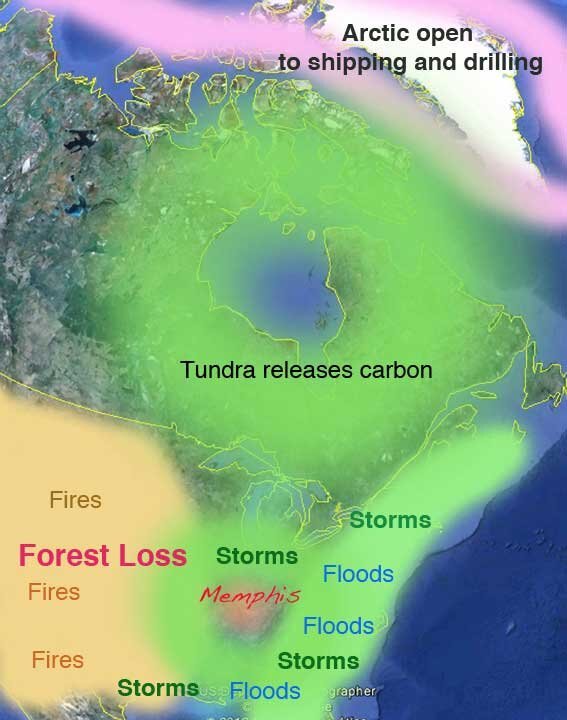
Opening the Arctic, Fish Story Date: 2012 Size: Variable Materials: Digital still generated with pen tablet and Photoshop Description: Mapping generated live during Gulf to Gulf webcast desktop sharing conversation on global warming, in preparation for Fish Story. The mapping was created to understand how opening the Arctic will affect dynamic relationships in the Northern hemisphere and fish in Memphis, TN.

X Fish Story River Painting in Installation Detail Date: 2013 Size: Installation 11' x 144' (132" x 1728") Materials: Acrylic paint on black paper with cut out handmade paper silhouettes of individual fish, photographs and mapping from previous workshop Description: Detail of Fish Story installation for Memphis Social at the Hyde Gallery, Memphis College of Art, Memphis, TN.

Fish Story Tributaries #4 Date: 2013 Size: 16" x 20" Materials: Encaustic on paper Description: Artifact from research for Fish Story on lowlands flooding in the outskirts of Memphis, TN.

Fish Story Canoeing the Wolf River Date: 2013 Size: Variable Materials: Digital photograph Description: Photograph taken from canoe by Dr. Eugene Turner in collaboration with Aviva Rahmani as they traversed the Wolf River towards the Mississippi River as research for a local trigger point. Rahmani directed then edited the shots. The canoe trip was the first of four Fish Story events for Memphis Social, curated by Tom McGlynn.
Provenance:
Stills from Fish Story were shown in the following exhibition: Memphis Social curated by Tom McGlynn of Beautiful Fields, Memphis College of Art's Hyde Gallery, Memphis, TN, May 10 – 18, 2013.
Publications:
Rahmani, Aviva. “Fish Story Memphis: Memphis is the Centre of the World”. Journal for Environmental Studies and Sciences [online] Vol. 4 (2; June): 176–179, 2013
Koeppel, Frederic. "'Memphis Social' Vast project spans breadth of city's arts scene." The Commercial Appeal [Memphis] 9 May 2013: 1M and 4M. Print, 2013.
Rahmani, Aviva. “A Community of Resistance: Collaborative Work with Science and Scientists.” WEAD Magazine. Online publication Issue 7, CREATING COMMUNITY, available at: http://weadartists.org/communities-art-science, 2014.
Oil & Water
Oil & Water (2010-2014) is a series of representations that emerged from studying the impact of climate change and economics on America’s Midwestern and Southern landscape.
“I took the original photograph for what became Oil & Water during the 2008 hurricane season. Traveling by train from Maine to the Gulf of Mexico and back, I saw how climate change and economics was changing America’s Midwestern and Southern landscape. It was during a Gulf to Gulf session in 2009, with scientists Dr. Eugene Turner and Dr. James White, that I made “Red Sky.” That was the first image of the Oil & Water series, capturing my sense of future danger to our environment. Subsequent images in the series were inspired by the tragic British Petroleum oil spill.” — Aviva Rahmani
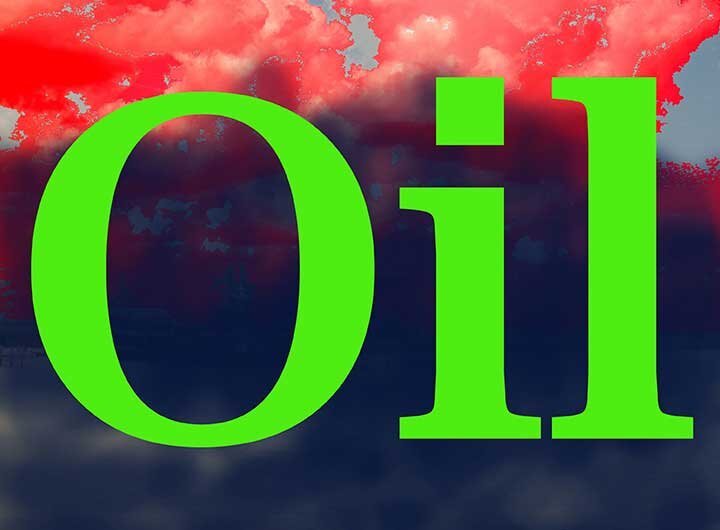
Oil & Water #8 detail of Oil & Water book, page #8 Date: 2011 Size: 11" x 11" Materials: Mixed media on Japanese Digital Niyodo Kozo paper. Description: The Oil & Water series was created for "One of a Kind," an exhibition of unique artist's books at Pierre Menard Gallery, Cambridge MA in 2011, "Unbound - An Exhibition in 3 Chapters" at the Dalhousie Art Gallery, Halifax, Nova Scotia in 2012, "One of a Kind III" at the Owens Art Gallery, Mount Allison University, New Brunswick, Canada, in 2013 and in "One of a Kind IV" and at the AC Institute, NYC, NY, also 2013, all curated by Heide Hatry.
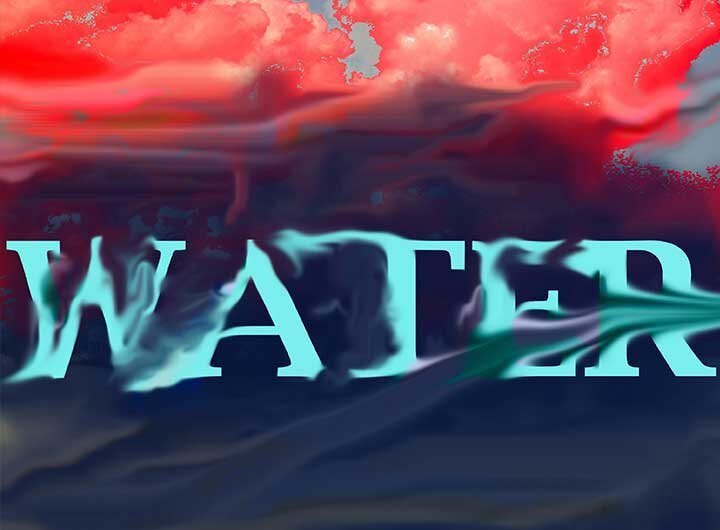
Oil & Water #6 detail of Oil & Water book, page #6 Date: 2011 Size: 11" x 11" Materials: Mixed media on Japanese Digital Niyodo Kozo paper. Description: The Oil & Water series was created for "One of a Kind," an exhibition of unique artist's books at Pierre Menard Gallery, Cambridge MA in 2011, "Unbound - An Exhibition in 3 Chapters" at the Dalhousie Art Gallery, Halifax, Nova Scotia in 2012, "One of a Kind III" at the Owens Art Gallery, Mount Allison University, New Brunswick, Canada, in 2013 and in "One of a Kind IV" and at the AC Institute, NYC, NY, also 2013, all curated by Heide Hatry.

Oil & Water #11 detail of Oil & Water book, page #11 Date: 2011 Size: 11” x 11” Materials: Mixed media on Japanese Digital Niyodo Kozo paper. Description: The Oil & Water series was created for "One of a Kind," an exhibition of unique artist's books at Pierre Menard Gallery, Cambridge MA in 2011, "Unbound - An Exhibition in 3 Chapters" at the Dalhousie Art Gallery, Halifax, Nova Scotia in 2012, "One of a Kind III" at the Owens Art Gallery, Mount Allison University, New Brunswick, Canada, in 2013 and in "One of a Kind IV" and at the AC Institute, NYC, NY, also 2013, all curated by Heide Hatry.

Options Data Choice Date: 2009 Size: 11” x 11” Materials: Mixed media on Japanese Digital Niyodo Kozo paper. Description: The Oil & Water series was created for "One of a Kind," an exhibition of unique artist's books at Pierre Menard Gallery, Cambridge MA in 2011, "Unbound - An Exhibition in 3 Chapters" at the Dalhousie Art Gallery, Halifax, Nova Scotia in 2012, "One of a Kind III" at the Owens Art Gallery, Mount Allison University, New Brunswick, Canada, in 2013 and in "One of a Kind IV" and at the AC Institute, NYC, NY, also 2013, all curated by Heide Hatry.
Provenance:
Oil & Water was first shown as a series of 15 images in an artist book for One of A Kind, an exhibition of unique artist's books, at Pierre Menard Gallery, Cambridge MA in 2011 then, Unbound – An Exhibition in 3 Chapters at Dalhousie Art Gallery, Halifax, Nova Scotia in 2012, One of a Kind III at Owens Art Gallery, Mount Allison University, New Brunswick, Canada in 2013 and also in 2013 at One of a Kind IV at AC Institute, New York, NY, all curated by Heide Hatry.”
Individual images from the Oil & Water series have also been shown in the following: SHFT, at 133 Greene Street, New York, NY in 2010 curated by Edie Kahula Pereira, in 2011 at Oil Spill: Information Gulf, at the Santa Fe Art Institute, Santa Fe, NM, curated by Katie Avery, Beyond the Horizon, at Deutsche Bank, New York, NY curated by Amy Lipton, Horizon Lines at ecoartspace New York, NY also curated by Amy Lipton and in 2013 for It's the End of the World as We Know it (and I Feel Fine), Ramapo College Art Galleries, Mahwah, NJ curated by Amy Lipton.
Publications:
Ernest, Dagney. “Rahmani opens, premiers in New York” The Herald Gazette. October 23, 2010.
Billard, Mary. “Saving the World. Smelling Good Too.” The New York Times. October 21 2010: E6. 2010.
Keim, Brandon. "Disturbing or Beautiful? Artists Evaluate Man's Impact on Nature" Weird Science August 10. Available online: http://www.wired.com/wiredscience/2011/08/beyond-the horizon/2011
Heartney, Eleanor. “The horsemen of eco-Armageddon” Art & Australia, Vol 49, No 2. pp: 308-313, Summer 2011.
Lippard, Lucy. Undermining: A Wild Ride Through Land Use, Politics, and Art in the Changing West. New York: New Press, 2014.
Cembalest, Robin. "101 Women Artists Who Got Wikipedia Pages This Week" ArtNews Online posting: http://www.artnews.com/2014/02/06/art-and-feminism-wikipedia-editathon-creates-pages-for-women-artists 2014.
Gulf to Gulf
Introduction
A series of on-going conversations between wetlands ecologist Gene Turner, paleoecologist Jim White, Aviva Rahmani and others called “Gulf to Gulf.” It came out of the “Cities and Oceans of If,” and the collaboration between White and Rahmani for the 2007 Weather Report show, curated by Lucy Lippard. Each conversation explores ways climate change is affecting gulf regions, linked to policy shifts and public attitudes.
Further Details
Gulf to Gulf engages artists and scientists in an ongoing mini think tank style research project and conversation on global warming in gulf regions, and how art can affect climate policy. Centrally a collaboration and ongoing series of webcast conversations between Aviva, Dr. Jim White, and Dr. Eugene Turner, the project has grown a collection of raw recordings of webcast conversations, including international guest artists and scientists, and has been accessed across eighty-five countries.
Gulf to Gulf began in 2009 as a project sponsored by the New York Foundation for the Arts. The focus of Gulf to Gulf is to effect climate-change policy with art, while observing the impacts of global warming on gulf regions internationally. Work includes site observation, interactive desktop sharing sessions, in webcasts with scientists and others led by Aviva Rahmani. The Blued Trees Symphony is part of Gulf to Gulf.
Documentation, analysis, and interpretation of new insights about climate change and global warming are presented in informal conversations between Aviva Rahmani and Dr. Jim White, paleoecologist (professor of geological sciences, fellow and director of the Institute for Arctic and Alpine Research, INSTAAR, at the University of Colorado at Boulder); Dr. Eugene Turner, wetlands biologist (distinguished research master and professor, Department of Oceanography and Coastal Sciences, Louisiana State University, Baton Rouge); and invited guests. Gulf to Gulf partners with WebServes (James Bradley)—developers of the Gulf to Gulf Project website—to broadly reconceive the definition of a site as geographic location and virtual interface. It presumes that physical, imaginative, and virtual sites can be interdependent.
The target of these conversations is climate change policy. Gulf to Gulf, a collection of raw recordings of webcast conversations, has been accessed from over eighty-five countries, and has a dedicated website. Guests have included the late Dr. Michele Dionne, former director of research at the Wells National Estuarine Research Reserve, Wells, Maine; Dr. Thomas Dunlap, environmental historian, professor at Texas A & M University; the philosopher Baird Callicott and Dr. Harvey Hix, an American poet, scholar, and professor at the University of Wyoming.
Gulf to Gulf builds on the previous Virtual Concerts format of free-flowing podcast discussions.
Red Sky Date: 2009 Size: Variable Materials: Digital photograph with Photoshop Description: Image captured from moving train in the Louisiana Bayous during hurricane season 2009, and later photoshopped.
Persian Gulf Date: 2009 Size: Variable Materials: digital drawing with Photoshop Description: Screen capture of still generated live during Gulf to Gulf desktop sharing sessions with a team of scientists and others.
Do Something Date: 2009 Size: Variable Materials: digital drawing with Photoshop Description: Screen capture of still generated live during Gulf to Gulf desktop sharing sessions with a team of scientists and others.
Options Data Choice Date: 2009 Size: Variable Materials: digital drawing with Photoshop Description: Screen capture of still generated live during Gulf to Gulf desktop sharing sessions with a team of scientists and others.
Provenance:
Stills from Gulf to Gulf were shown in the following exhibition: Still Waters, curated by Lisa Alembik, Dalton Gallery, Agnes Scott College Decatur, GA, 2009.
Publications:
Carpenter, Lucas. “Review of Still Waters Show,” Art Papers p. 50, January/February 2010.
Redelius, Gunilla. “Aviva Rahmani Projects” LabforCulture.org http://www.labforculture.org/en/home/contents/climate-change-artists-respond/artistic-projects/aviva-rahmani-projects posted November 16th 2010.
Felde, Lena. “Gulf to Gulf Talk Online,” Cultura21 posting on the CSPA website http://www.sustainablepractice.org/2014/10/04/gulf-to-gulf-talk-online/ Posted September 21, 2014.
Trigger Points/Tipping Points
Trigger Points / Tipping Points is a series of works developed out of a collaboration with scientist Dr. Jim White. The project consisted of a series of computer images that assembled and manipulated satellite images to predict and speculate on the relationships between the impacts of global warming on major river deltas that were also the sites of conflict zones, such as the Ganges, the Nile, and the Mississippi River.
Trigger Points / Tipping Points, a work by Aviva Rahmani and paleoecologist Dr. Jim White of the Institute for Arctic and Alpine Research (INSTAAR) at the University of Colorado in Boulder, where Rahmani is an affiliate, was initiated in 2007 by Marda Kirn of EcoArts Connections (EAC). Kirn asked Lucy Lippard to curate an exhibition, pairing a number of artists and scientists to collaborate on a project called Weather Report: Art and Climate Change, co-produced by EAC and Boulder Museum of Contemporary Art in Boulder, Colorado. Trigger Points / Tipping Points premiered at the 2007 Venice Biennale and was subsequently shown at additional international venues, including sites in New York City and in Russia.
The topic over six months of regular desktop-sharing sessions was the impact of global warming on conflict zones around the world in relation to river systems, such as, Bangladesh and the Ganges; Darfur and the Nile; and New Orleans and the Mississippi. Installation stills and a 20-minute video were generated from the desktop-sharing webcasts.
“we don’t need hope, we need (your) honesty”
Spencer Koonin and Mae Kennedy, President/Vice President of the Princeton Conservation Society, 2022, upon the occasion of Aviva Rahmani’s talk and trigger point workshop at Princeton University October 4, 2022.
Trigger Points Tipping Points Grid Date: 2007 Size: 47" x 52" Materials: Grid of digitized prints on archival paper Description: Installallation of screen capture stills generated live during desktop sharing sessions with Dr. Jim White, for the Weather Report Show curated by Lucy Lippard for the Boulder Museum of Contemporary Art, Boulder, Colorado.
Mississippi 2040 detail of Trigger Points/ Tipping Points installation Date: 2007 Size: 13" x 19" Materials: digitized print on archival paper Description: Still created in collaboration with Dr. Jim White, for the 2007 Weather Report show, curated by Lucy Lippard for the Boulder Museum of Contemporary Art, Boulder, Colorado.
New Orleans in Gulf of Mexico detail of Trigger Points/ Tipping Points Installation Date: 2007 Size: 13" x 19" Materials: digitized print on archival paper Description: Still created in collaboration with Dr. Jim White, for the 2007 Weather Report show, curated by Lucy Lippard for the Boulder Museum of Contemporary Art, Boulder, Colorado.
Bangladesh Ganges Erased detail of Trigger Points/ Tipping Points Installation Date: 2007 Size: 13" x 19" Materials: digitized print on archival paper Description: Still created in collaboration with Dr. Jim White, for the 2007 Weather Report show, curated by Lucy Lippard for the Boulder Museum of Contemporary Art, Boulder, Colorado.
Provenance:
Stills from Trigger Points/Tipping Points have been shown in the following exhibitions: Weather Report, curated by Lucy Lippard, Boulder Museum of Contemporary Art, Boulder, CO, September 14 - December 12, 2007; The Cultura21 Group at the Joseph Beuys 100 days of Conference Pavilion, Venice Biennale, Venice, Italy, September 6, 2007; Feeling the Heat, curated Liz Christensen, Deutsche Bank Art Gallery, New York City, NY, June, 2008; In Transition Russia 2008, curated by Sheila Pinkel, The Independent Museum of Contemporary Art (IMCA), Cyprus and NeMe in collaboration with the National Centres of Contemporary Art (NCCA), Ekaterinburg and Moscow, Russian Federation and Climate Change: Conveying Realities curated by Chris Cuomo, eco*art*lab, Athens GA, March 23 - April 27, 2013.
Publications:
Dederer, Claire. "Looking for Inspiration in the Melting Ice." Sunday Arts & Leisure, New York Times September 23, 2007.
Lippard, Lucy. Weather Report. Boulder Museum of Contemporary Art, Boulder Colorado, 2007.
Black, Helene and Pinkel, Sheila. In Transition Russia 2008. Presented by NeMe, 2008.
Boettger, Suzaan. "Global Warnings." Art in America, illustrated page 161, discussed page 206, June/July 2008.
Boettger, Suzaan. "Global Warnings." Art in America, illustrated page 161, discussed page 206, June/July 2008.
Climate Change / Global Warming
Aviva Rahmani has been concerned about climate change throughout her career. In Ghost Nets, she experimented with planting vegetation for a more temperate climate, such as Magnolia grandiflora, to track how well they would flourish as the site warmed with the rest of the planet. Her concern with climate change went to the top of her priorities in 2005 after the dramatic catastrophe of Hurricane Katrina.





